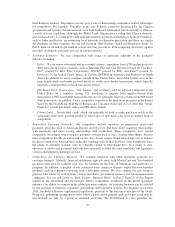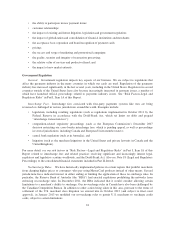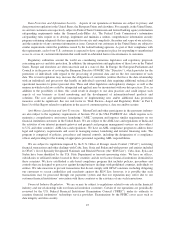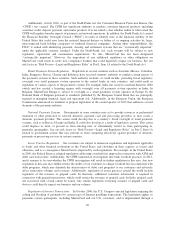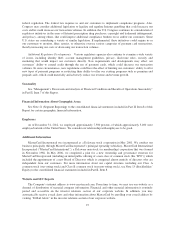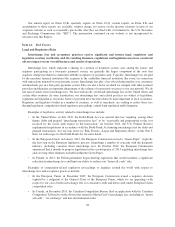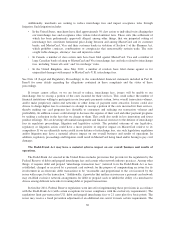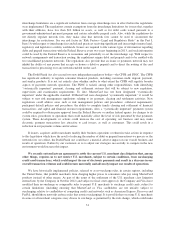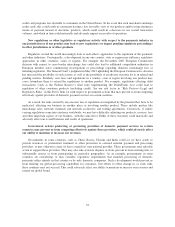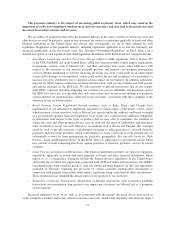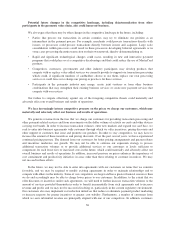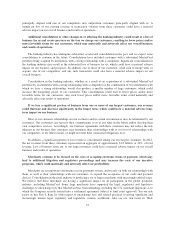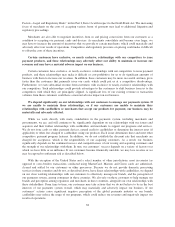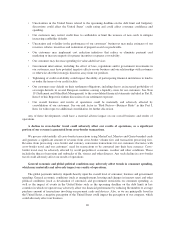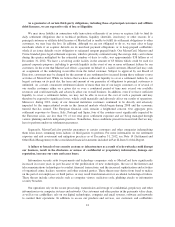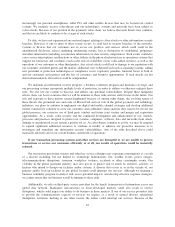MasterCard 2012 Annual Report Download - page 36
Download and view the complete annual report
Please find page 36 of the 2012 MasterCard annual report below. You can navigate through the pages in the report by either clicking on the pages listed below, or by using the keyword search tool below to find specific information within the annual report.credit card programs less desirable to consumers in the United States. In the event that such merchants surcharge
credit cards, this could result in consumers having a less favorable view of our products and/or using alternative
means of payment instead of electronic products, which could result in a decrease in our overall transaction
volumes, and which in turn could materially and adversely impact our results of operations.
New regulations or other legislative or regulatory activity with respect to the payments industry in
one jurisdiction or of one product may lead to new regulations (or impact pending regulatory proceedings)
in other jurisdictions or of other products.
Regulators around the world increasingly look at each other’s approaches to the regulation of the payments
and other industries. Consequently, a development in any one country, state or region may influence regulatory
approaches in other countries, states or regions. For example, the December 2007 European Commission
decision with respect to cross-border interchange fees could also lead to additional competition authorities in
European member states commencing investigations or proceedings regarding domestic interchange fees or
initiating regulation. The General Court’s judgment in May 2012 upholding the European Commission’s decision
has increased the possibility of such actions, as well as the possibility of an adverse outcome for us in related and
pending matters. Similarly, new laws and regulations in a country, state or region involving one product may
cause lawmakers there to extend the regulations to another product. For example, regulations affecting debit
transactions (such as the Federal Reserve’s final rules implementing the Dodd-Frank Act) could lead to
regulation of other consumer products (including credit). See our risk factor in “Risk Factors—Legal and
Regulatory Risks” in this Part I, Item 1A with respect to government actions that may prevent us from competing
effectively against providers of domestic payment services in certain countries.
As a result, the risks created by any one new law or regulation are magnified by the potential they have to be
replicated, affecting our business in another place or involving another product. These include matters like
interchange rates, network standards and network exclusivity and routing agreements. Conversely, if widely
varying regulations come into existence worldwide, we may have difficulty adjusting our products, services, fees
and other important aspects of our business, with the same effect. Either of these outcomes could materially and
adversely affect our overall business and results of operations.
Government actions preferring or protecting providers of domestic payment services in certain
countries may prevent us from competing effectively against those providers, which could adversely affect
our ability to maintain or increase our revenues.
Governments in some countries, such as China, Russia, Ukraine and India could act (or have acted) to
provide resources or preferential treatment or other protection to selected national payment and processing
providers, or may otherwise create (or have created) its own national provider. These governments may take this
action to support these providers. They may also take action to displace us from, prevent us from entering into, or
substantially restrict us from participating in, particular geographies. As an example, governments in some
countries are considering, or may consider, regulatory requirements that mandate processing of domestic
payments either entirely in that country or by only domestic companies. Such a development would prevent us
from utilizing our global processing capabilities for customers. Our efforts to effect change in, or work with,
these countries may not succeed. This could adversely affect our ability to maintain or increase our revenues and
extend our global brand.
32


